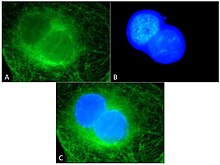Binucleated cells
This articleneeds additional citations forverification.(August 2024) |
| Binucleated cells | |
|---|---|
 | |
| A binucleated cell has two nuclei. The cell above was stained with DAPI to highlight the nuclei and treated with antibodies against tubulin to highlight the microtubules to show the binucleation. | |
| Specialty | Pathology |
Binucleated cellsarecellsthat contain twonuclei.This type of cell is most commonly found incancercells and may arise from a variety of causes. Binucleation can be easily visualized throughstainingandmicroscopy.In general, binucleation has negative effects on cell viability and subsequentmitosis.
They also occur physiologically inhepatocytes,chondrocytesand infungi(dikaryon).
Causes
[edit]- Cleavage furrowregression: Cells divide and almost complete division but then thecleavage furrowbegins to regress and the cells merge. This is thought to be caused bynondisjunctioninchromosomesbut the mechanism by which it occurs is not well understood.[1]

- Failedcytokinesis:The cell can fail to form a cleavage furrow, leading to both nuclei remaining in one cell.[1]
- Multipolar spindles:Cells contain three or morecentrioles,resulting in multiple poles. This leads to the cells pullingchromosomesin many directions that end in multiplenucleifound in one cell.[1]
- Merging of newly formed cells: Two cells that have just finishedcytokinesismerge into one another. This process is not entirely understood.[1]
Medical relevance
[edit]Detection
[edit]Binucleated cells can be observed usingmicroscopy.Cells must first befixedto arrest them wherever they are in thecell cycleand to keep their structures from degrading. Theirnucleiandtubulinmust next be made visible so that binucleation can be identified.DAPIis a dye that binds toDNAand fluoresces blue. For this reason, it is particularly useful at labeling nuclei.Antibodyprobes can be used to labeltubulinfluorescently. Theimmunofluorescencemay then be observed withmicroscopy.Binucleated cells are most easily identified by viewingtubulin,which surrounds the two nuclei in the cell. Binucleated cells may be mistaken for two cells in close proximity when viewing only nuclei.

Cancer
[edit]Binucleation occurs at a much higher rate incancercells.[1]Other identifying features ofcancercells includemultipolar spindles,micronuclei,andchromatin bridge.However, the increased rate of binucleation is usually not high enough to make it a conclusive diagnostic tool.
Effects
[edit]The fate of binucleated cells depends largely on the type of cell they originated from.[1]A large percentage of binucleated cells arising from normal cells remain ininterphaseand never entermitosisagain.[1]Cells that contain manymutationsbefore they become binucleate are much more likely to proceed through subsequent rounds of mitosis.[1]One study found that more than 50% of binucleated cells never entered mitosis again while greater than 95% of cancer cells were able to proceed through mitosis.[1]Subsequent rounds of mitosis in binucleated cells have much higher rates of errors inchromosomaldisjunction making it much more likely for cells to accumulatemutations.[1]
